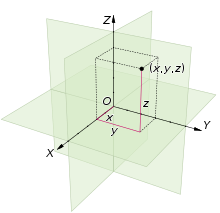Concepts of Computer Graphics/Input Space/Measuring Space

We immediately face a problem very similar to our problem when we were trying to understand how to represent color as numbers in digital form. Specifically, how do we represent a geometric object in digital form?
Most of us are familiar with the Cartesian coordinate system we are taught in school. The Cartesian coordinate system lets us denote the position of objects in space relative to two axes in space. We then locate a point in space by its position along the two axes, where we consider the place where the axes cross to be the "zero" location. Because these axes are abstract ideas that extend infinitely in every direction, it is as if we have created a universal measuring stick for space (specifically a two dimensional plane in this case). It does not matter where we set the axes, or in which direction they point (as long as the axes are at right angles to each other), we can still measure the distances along each axis, and in so doing locate a given point in space.
Thus, if we are given a collection of points, our choice for how we place the Cartesian coordinate system axes is entirely unimportant, the relationships between the points will be maintained.